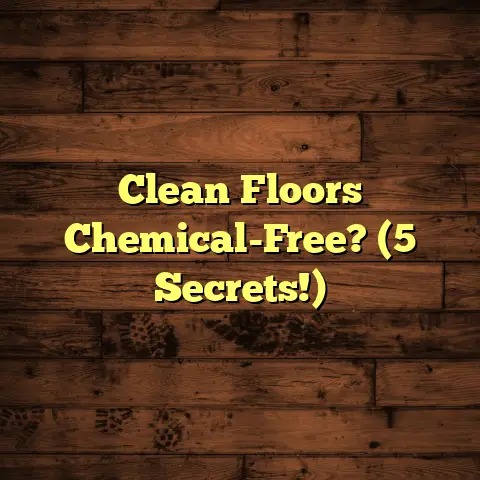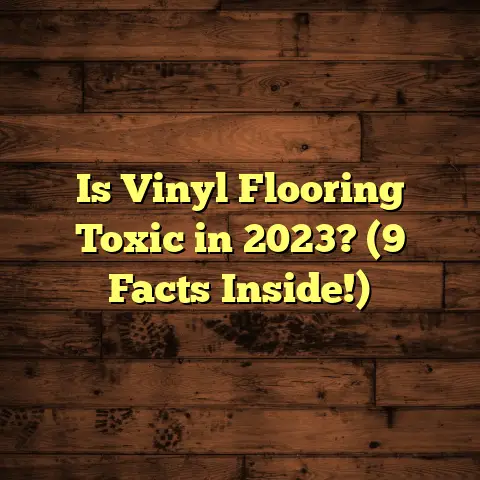Laminate vs. Vinyl: Which is Best? (3 Top Flaws!)
Okay, buckle up, because we’re diving deep into the world of flooring! Laminate and vinyl – they’re the rockstars of affordable and stylish floors right now. But which one reigns supreme? And more importantly, what are their dirty little secrets? We’re about to uncover the three top flaws you absolutely NEED to know before making a decision.
Laminate vs. Vinyl: Which is Best? (3 Top Flaws!)
Introduction: Riding the Renovation Wave
Have you noticed? Everyone and their grandma seems to be renovating these days! And one of the biggest changes people make? You guessed it – the floors!
I’ve been a flooring contractor for over 15 years, and let me tell you, I’ve seen it all. From shag carpets that could hide a small family to linoleum patterns that belonged in a time capsule. But now? It’s all about that sweet spot: floors that look amazing, can handle life’s messes, and don’t break the bank.
That’s where laminate and vinyl come in.
These two have EXPLODED in popularity. Why? Because they offer a fantastic blend of aesthetics, durability, and cost-effectiveness. I’m seeing them everywhere, from modern condos to cozy family homes.
According to a recent report by Statista, the global laminate flooring market is projected to reach $44.7 billion by 2027. And the vinyl flooring market? It’s not far behind, with a projected value of $75.1 billion by 2028, according to Grand View Research. Those are some serious numbers!
But here’s the thing: not all laminate and vinyl are created equal. And they both have their downsides. That’s why I’m here – to give you the straight goods, the warts and all, so you can make the best choice for your home.
Ready to get started? Let’s jump in!
Section 1: Understanding Laminate Flooring
Okay, let’s kick things off with laminate. What exactly is this stuff?
Definition and Composition
Laminate flooring is basically a multi-layered synthetic flooring product fused together through a lamination process. Think of it like a high-tech sandwich.
It typically consists of four main layers:
-
Backing Layer: This is the foundation, providing stability and moisture resistance from below.
-
Core Layer: Usually made of high-density fiberboard (HDF) or medium-density fiberboard (MDF), this layer gives the laminate its strength and impact resistance.
-
Design Layer: This is where the magic happens! A high-resolution photographic image of wood, stone, or tile is printed onto this layer.
-
Wear Layer: This is the top layer, a transparent coating that protects the design layer from scratches, stains, fading, and wear. The thicker the wear layer, the more durable the laminate.
Types of Laminate Flooring
Not all laminates are created equal. You’ll find different types on the market, each with its own strengths and weaknesses.
-
High-Pressure Laminate (HPL): This is the heavy-duty stuff. The layers are fused together under high pressure, making it incredibly durable and resistant to impact. It’s often used in commercial settings.
-
Direct-Pressure Laminate (DPL): This is the most common type of laminate for residential use. It’s less expensive than HPL, but still offers good durability.
-
Waterproof Laminate: This is the new kid on the block, and it’s a game-changer. It has a special core and locking system that prevents water from penetrating the floor. It’s perfect for bathrooms, kitchens, and other areas prone to moisture.
Durability and Maintenance
Laminate is generally a pretty tough cookie. It’s resistant to scratches, dents, and fading, making it a good choice for busy households with kids and pets.
The key to long-lasting laminate is proper maintenance. Here are a few tips:
-
Sweep or vacuum regularly: This will remove dirt and debris that can scratch the surface.
-
Use a damp mop: Avoid soaking the floor, as excessive moisture can damage the core.
-
Use a laminate floor cleaner: Avoid harsh chemicals or abrasive cleaners.
-
Place mats at entrances: This will help trap dirt and moisture before they get onto the floor.
-
Use furniture pads: This will protect the floor from scratches and dents.
Aesthetic Appeal
One of the biggest draws of laminate is its aesthetic versatility. Thanks to advancements in printing technology, laminate can mimic the look of real wood, stone, and tile with incredible realism.
You can find laminate in a wide range of colors, patterns, and textures. Whether you’re going for a rustic farmhouse look or a sleek modern vibe, there’s a laminate out there to match your style.
Cost Considerations
Laminate is generally more affordable than hardwood, stone, or tile. The price range can vary depending on the quality, thickness, and brand, but you can typically expect to pay between $2 and $5 per square foot for the material itself.
Installation costs can also vary depending on the complexity of the job and the installer’s rates. However, laminate is relatively easy to install, especially the click-lock systems, which can save you money on labor costs.
Common Flaws of Laminate Flooring
Okay, now for the moment of truth. Let’s talk about the downsides of laminate.
-
Flaw 1: Limited Water Resistance Leading to Warping
This is the BIGGEST issue with traditional laminate. While it’s resistant to spills, it’s not completely waterproof. If water seeps into the seams between the planks, it can cause the core to swell and warp.
I’ve seen countless laminate floors ruined by leaky dishwashers, overflowing sinks, and even just excessive mopping.
This is why waterproof laminate is becoming so popular. It addresses this major flaw and gives you peace of mind.
-
Flaw 2: Lack of Authenticity Compared to Real Wood or Stone
Let’s be honest, while laminate has come a long way in terms of realism, it’s still not the real deal. It lacks the natural variations, grain patterns, and warmth of real wood or stone.
If you’re a purist who values authenticity above all else, laminate might not be for you.
-
Flaw 3: Potential for Fading and Wear Over Time
While laminate is durable, it’s not indestructible. In high-traffic areas, the wear layer can eventually wear down, revealing the design layer underneath. Sunlight can also cause the colors to fade over time.
This is why it’s important to choose a laminate with a thick wear layer and to take steps to protect it from excessive wear and tear.
Section 2: Understanding Vinyl Flooring
Alright, let’s switch gears and talk about vinyl flooring. This is another incredibly popular option, and for good reason.
Definition and Composition
Vinyl flooring is a synthetic flooring material made from polyvinyl chloride (PVC) and other compounds. It’s known for its durability, water resistance, and versatility.
There are two main types of vinyl flooring:
-
Luxury Vinyl Tiles (LVT): These are individual tiles or planks that mimic the look of real wood, stone, or ceramic tile. They’re typically thicker and more durable than vinyl sheets.
-
Vinyl Sheets: These are large rolls of vinyl flooring that are installed in a single sheet. They’re less expensive than LVT and offer excellent water resistance, making them a good choice for bathrooms and kitchens.
Types of Vinyl Flooring
Within LVT and vinyl sheets, you’ll find different constructions and features:
-
Solid Vinyl: This is made of a single layer of vinyl. It’s durable and water-resistant, but can be less comfortable underfoot than other options.
-
Composite Vinyl: This has a core layer made of foam or felt, which provides cushioning and sound absorption.
-
Wear Layer: Just like laminate, vinyl flooring has a wear layer that protects the design layer. The thicker the wear layer, the more durable the vinyl.
-
Printed Vinyl: The design is printed directly onto the vinyl surface. This is the most common and affordable type of vinyl.
-
Inlaid Vinyl: The design is created by embedding small pieces of colored vinyl into the flooring. This creates a more durable and realistic look.
Durability and Maintenance
Vinyl is known for its excellent durability and water resistance. It can stand up to moisture, scratches, and heavy foot traffic, making it a great choice for busy households.
Here are some tips for maintaining vinyl floors:
-
Sweep or vacuum regularly: This will remove dirt and debris that can scratch the surface.
-
Use a damp mop: Avoid soaking the floor, as excessive moisture can damage the adhesive underneath.
-
Use a vinyl floor cleaner: Avoid harsh chemicals or abrasive cleaners.
-
Place mats at entrances: This will help trap dirt and moisture before they get onto the floor.
-
Use furniture pads: This will protect the floor from scratches and dents.
Aesthetic Appeal
Vinyl has come a long way in terms of aesthetics. Thanks to advancements in printing technology, it can now mimic the look of real wood, stone, and tile with incredible realism.
You can find vinyl in a wide range of colors, patterns, and textures. LVT, in particular, offers a very realistic look, with embossed textures and beveled edges that mimic the look of real wood or stone planks.
Cost Considerations
Vinyl is generally one of the most affordable flooring options. The price range can vary depending on the quality, thickness, and brand, but you can typically expect to pay between $1 and $5 per square foot for the material itself.
Installation costs can also vary depending on the complexity of the job and the installer’s rates. However, vinyl is relatively easy to install, especially LVT with click-lock systems, which can save you money on labor costs.
Common Flaws of Vinyl Flooring
Okay, let’s talk about the downsides of vinyl.
-
Flaw 1: Vulnerability to Gouges and Tears
While vinyl is durable, it’s not impervious to damage. Sharp objects can easily gouge or tear the surface, especially if it’s a thinner vinyl sheet.
I’ve seen vinyl floors ruined by dropped knives, scratches from pets’ claws, and even just dragging heavy furniture across the floor.
This is why it’s important to choose a vinyl with a thick wear layer and to be careful when handling sharp objects or moving furniture.
-
Flaw 2: Potential for Off-Gassing and Environmental Concerns
Vinyl is made from PVC, which is a petroleum-based plastic. Some vinyl flooring can release volatile organic compounds (VOCs) into the air, which can be harmful to your health. This is known as off-gassing.
There are also environmental concerns associated with the production and disposal of PVC.
To minimize these risks, look for vinyl flooring that is certified by independent organizations like FloorScore or GreenGuard. These certifications ensure that the flooring meets strict standards for VOC emissions and environmental impact.
-
Flaw 3: Risk of Indentations from Heavy Furniture or Appliances
Vinyl is relatively soft, which means that it can be susceptible to indentations from heavy furniture or appliances.
I’ve seen vinyl floors with permanent indentations from sofas, refrigerators, and even just the legs of dining room tables.
To prevent this, use furniture pads under heavy items and avoid placing them directly on the vinyl floor.
Section 3: Direct Comparison of Laminate and Vinyl Flooring
Alright, now that we’ve covered the basics of both laminate and vinyl, let’s put them head-to-head and see how they stack up.
Head-to-Head Comparison
Here’s a table summarizing the key differences between laminate and vinyl flooring:
| Feature | Laminate | Vinyl |
|---|---|---|
| Durability | Good, resistant to scratches and dents | Excellent, resistant to moisture and wear |
| Water Resistance | Limited, prone to warping if not sealed | Excellent, waterproof |
| Installation | Easy, click-lock systems available | Easy, click-lock and glue-down options |
| Aesthetics | Realistic wood and stone looks | Realistic wood and stone looks |
| Cost | Moderate, $2-$5 per square foot | Affordable, $1-$5 per square foot |
| Maintenance | Easy, damp mopping | Easy, damp mopping |
| Comfort | Can be hard and cold underfoot | Softer and warmer underfoot |
| VOC Emissions | Can emit VOCs, look for certifications | Can emit VOCs, look for certifications |
| Environmental Impact | Can be made from recycled materials | Can be made from recycled materials |
User Experiences and Testimonials
I’ve talked to hundreds of homeowners over the years about their experiences with laminate and vinyl. Here are a few quotes that stand out:
-
“I love my laminate floors! They look just like real wood, and they’re so easy to clean. But I did have a problem with water damage in my kitchen when the dishwasher leaked.” – Sarah, homeowner
-
“I chose vinyl for my bathroom because I wanted something that was completely waterproof. I’ve been really happy with it. It’s held up great to spills and splashes.” – Mark, homeowner
-
“I regret getting vinyl. It looked great at first, but it’s already starting to show scratches and dents from my dog’s nails.” – Jessica, homeowner
These quotes highlight the importance of considering your specific needs and lifestyle when choosing between laminate and vinyl.
Market Trends and Consumer Preferences
As I mentioned earlier, both laminate and vinyl are incredibly popular flooring options. But which one is more popular?
According to industry reports, vinyl flooring is currently experiencing faster growth than laminate. This is likely due to its superior water resistance and the increasing demand for waterproof flooring options.
However, laminate still holds a significant share of the market, particularly in areas where water resistance is less of a concern.
Environmental Impact
Both laminate and vinyl can have environmental impacts, but manufacturers are increasingly adopting sustainable practices to minimize these impacts.
Laminate can be made from recycled wood fibers, and some manufacturers use formaldehyde-free adhesives to reduce VOC emissions.
Vinyl can also be made from recycled materials, and some manufacturers are developing bio-based vinyl flooring made from renewable resources.
When choosing between laminate and vinyl, look for products that are certified by independent organizations like FloorScore, GreenGuard, or the Forest Stewardship Council (FSC). These certifications indicate that the products meet strict standards for environmental performance.
Final Thoughts on Comparison
So, which is better, laminate or vinyl? The truth is, there’s no one-size-fits-all answer. It depends on your specific needs, budget, and aesthetic preferences.
Laminate is a good choice if you want a realistic wood or stone look at an affordable price, and you’re not overly concerned about water resistance.
Vinyl is a good choice if you need a waterproof flooring option that can stand up to heavy traffic and moisture.
Conclusion: Summary of Findings
Alright, we’ve covered a LOT of ground! Let’s recap the key takeaways:
-
Laminate and vinyl are both popular and affordable flooring options.
-
Laminate is made from multiple layers of synthetic materials, while vinyl is made from PVC.
-
Laminate offers a realistic wood or stone look, while vinyl is known for its excellent water resistance.
-
The three top flaws of laminate are: limited water resistance, lack of authenticity, and potential for fading and wear.
-
The three top flaws of vinyl are: vulnerability to gouges and tears, potential for off-gassing, and risk of indentations.
Ultimately, the best flooring choice for you depends on your individual needs and priorities. Weigh the pros and cons of each option carefully, and don’t be afraid to ask questions and do your research.
Happy flooring!





